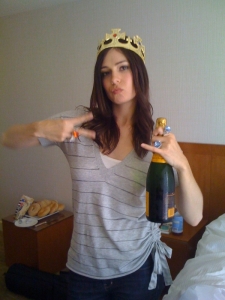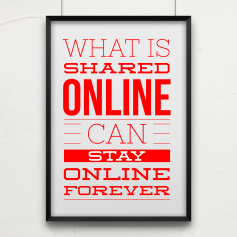
Image source: Flickr user Veronica Belmont, Creative Commons
I recently came across a 2013 Huffington Post article written by social media and brand strategist Kim Garst. Garst recently re-shared her article, Social Media: A Serious Threat to Your Child’s Professional Future in her Twitter feed. It’s worth repeating Kim, thanks!
I’ve written about my own journey to develop my personal/professional brand. Getting on board to brand myself on social media wasn’t difficult. Several decades of life experiences and a healthy dose of common sense along with some expert social media training, I found that shaping my “brand” such as it is, wasn’t a terribly hard task.
For teenagers, it’s more challenging. I was lucky. I grew up in the late 60s and early 70s. When I came of age, I experimented, tested, pushed limits and boundaries, a time that is happily (for me) scantily documented in a few, color-faded family photos (without the aid of an Instagram filter) depicting a girl in some very questionable platform shoes and boldly-printed polyester bell-bottom pants. My thoughts and opinions at the time do not accompany these few retro images staring back at me.
As a teenager, I formed and abandoned opinions impulsively. I communicated unsophisticatedly, passing folded paper notes to a classmate. My tears and giggles confessed to my best friend during sleepovers, are mine and mine alone, some filed away in my memory, some occasionally recalled, but most are long forgotten.
These experiences, rites of passage, successes, and mistakes, played a role in who I am today, but they have not followed me lock, stock and barrel into the present. I can’t tell you how happy I am about this.
Social media is changing all of that. Today, as in the past, adolescents, teenagers, and young adults continue to express themselves and experiment. But now, they do so with the eyes of the world upon every move they make. They will not know the privilege of anonymity and privacy that I enjoy then and now. It is a different world for emerging generations. Today, even content posted to a trusted friend, with privacy assumed, can instantly and easily be shared, sometimes with devastating results. And once it’s there, it’s there forever. What happens in Vegas stays in Vegas is a canard — a dangerous fantasy!
Forever! Translation: It doesn’t go away.
Snapchat, Twitter, Instagram, Facebook, Vine and whatever else comes down the social media pike, young people are sharing their lives — seemingly every aspect of their lives — on social media.
Annoying duck faces and narcissistic bathroom poses only scratch the surface of the problem. It’s the F-bombs, the political opinions, the fury, the angst, the political incorrectness, insults, barbs and expressions of sexuality, that are aggregated and curated, and paint a portrait of real people with names and lives — portraits which cannot be unseen. It is the judgment pieces (or lack thereof) which linger, ready to haunt youth as they begin to apply for internships, jobs, scholarships and other opportunities.
 We silly adults. We worry too much. Youth are both blessed and cursed with a confidence of immortality and invulnerability. Admirably, the bravery helps them try new things and take risks. But they are not immune to risk’s high toll, just ask any insurance agent.
We silly adults. We worry too much. Youth are both blessed and cursed with a confidence of immortality and invulnerability. Admirably, the bravery helps them try new things and take risks. But they are not immune to risk’s high toll, just ask any insurance agent.
I’ve embraced social media. I get it. These platforms are here to stay and everyone is using them. I want teens to use it smarter.
The fact is, some day, these rising adults will grow older and look back at their virtual profile and say, “Oh god, I can’t believe I … [fill in the blanks].” Fortunately for me, my cringe-worthy moments are tucked away in a few yearbook and family photos. This generation’s words, images, and six-second videos are not. They are chronicled and splattered all over the Internet, easily called up, in seconds, by a future relationship, scholarship grantor, college application panel, business associate or future employer. Teens will be defined by others based on their searchable profile —their online brand. But will it be the brand they want?
Teens are going to do dumb stuff. Teens can do dumb stuff smarter.
Here are some suggestions for teens and parents to consider as they come of age in our social media environment. Kids will be kids. Bottom line: experiment and make mistakes under a moniker or handle that does not expose your real name.
- Your name and image are a brand. Treat it as such. Protect it. Manage it. At 13 (the earliest age at which most social media platforms legally allow a person to participate) you are beginning the journey to write a book about who you are. It is a book you must assume EVERYONE can read. Personal information and experienced shared under your real name should be inoffensive, truthful and not controversial.
- Use a pseudonym for the silly and controversial stuff. If I wanted to talk politics, pop-culture, or my private life, I wouldn’t do it under my personal or professional brand. I’d have another account to express those opinions and share those details. Talk about your private love life with a secondary account. Use choice language here. Be outrageous here. Work out your growing pains with some level of anonymity. Your future boss might hold completely opposite political beliefs. Do you really want to go there and call his or her hero a jerk, or something far worse?
- Multiple accounts for multiple purposes. Accounts using your real name should contain content that your parents, grandparents, teachers and future influencers to whom you might apply (higher ed, jobs) could look to and say, “My, what a fine young person this is! How thoughtful!” It’s not being phony, it’s being smart.
- You have no right to privacy. Sorry, you don’t. You put something out there, it is up for grabs. Once posted, your content is at the mercy of your social media relationships. If you are a “friend collector” rest assured that the majority of the 500, 1,000 or 5,000 people who like or follow you are not true friends.
- Use consistent images under your own name. We’re going for wholesome here. Do you look employable or do you look like you are going to seduce someone’s spouse? Geesh, if you have to post suggestive poses, hand gestures, do it on another account.
- Bury the bad. Is there content on the web you wish wasn’t there? Bury it. Most people search the first few pages of a search engine. As you add new content, the old content becomes harder to find.
- Google yourself. Put your name in quotes, followed by your state, school or another identifier. What comes up under the web, image or video results?
- Start a blog. A blog is your personal/professional platform and a superb way to shape a lasting profile and brand. Write about school subjects, causes you believe in, community service you have provided, trips you have taken and other positive experiences. Use your real name. Post frequently. Blog posts often float to the top of search engines. I know one young man who got nabbed by the police for under-aged drinking and a little bit of high-school mischief that led to an arrest record, mug-shot, and a permanent record on the Internet. He grew out of all that nonsense and has shaped himself into a fine young man, but sure enough, a father of a girl this nice man was texting and hoping to date got Googled. Guess what popped up? Yep, the mug shot. The relationships never got off the ground. A blog and saturation of positive content associated with his name might be his answer to No.7.
- Create a LinkedIn profile. Okay, you might not have a work history yet, but you can share topics about the career you do want. You can demonstrate your thoughtfulness and curating ability. You can post original blog content and network with future employers, schools, and other influencers.
- Don’t avoid social media. It’s here, it’s real and it is a social networking tool that businesses, especially, pay attention to. A social media presence is an indicator of how well you network, and a useful mechanism for doing business.
Truth, honesty, and authenticity is always the ideal on social media, but to use a sports analogy, you are the star athlete AND the agent that represents the athlete and the PR machine all in one. Every post may become the next line in your autobiography. The minute you enter the online world, at age 10, 13 or 22 or 32, be mindful about positioning who you are and take an active role in shaping how others will see your persona and form an opinion about your reputation, today in years to come. Control is all at your social media fingertips.
Crafting your online identity is a must for developing a positive online brand. In the social media era, it is a process that needs to begin on the first day we open our first social media account.
Red/white graphic: walfred

Love this post!! Just moved to WordPress and delighted to stumble across you. Looking forward to more 👍🏻
LikeLike